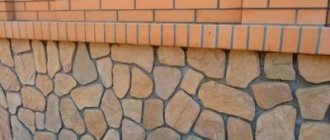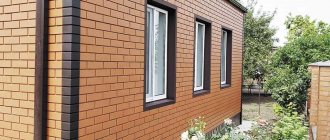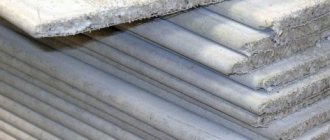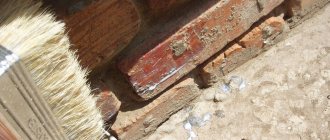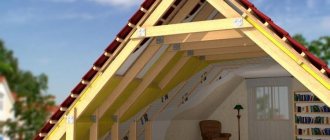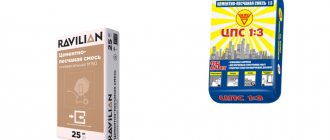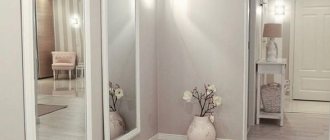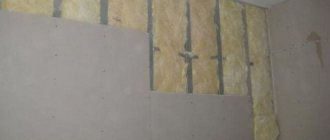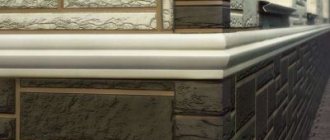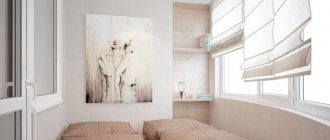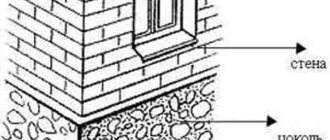The construction of any house begins with laying a foundation, the task of which, first of all, is to ensure the strength and durability of the entire structure. That part of it that rises above the ground is called the base and requires special attention to the selection of cladding, since it should not only harmoniously complement the appearance of your home, but also protect the foundation from all possible types of negative influence.
Types of base
When choosing a finishing material, you should take into account the design features of the base, which comes in three types:
- A protrusion that extends several centimeters beyond the contours of the building. Ideal for thin walls. Requires mandatory protective flashings for water drainage.
- Built flush with the wall. A flush plinth increases the likelihood of condensation accumulating inside the building.
- Sunken when the contour of the base is smaller in diameter than the contour of the house. Economical option, does not require additional drainage.
In any option, the base must be protected with an external moisture-resistant finish to protect the foundation and building from destruction.
Ceiling and lamps
The ceiling in any room plays a significant role. Proper finishing of the ceiling allows you to make rooms visually wider, disguise communications and even divide the room into zones.
Stretch ceiling with lamps.
Since quite a few UV rays enter the semi-basement room, it is necessary to take care of good artificial lighting in advance. To do this, you will need a lot of lamps, which are best distributed evenly across the ceiling. To give the ceiling a sophisticated look, you can use suspended structures and multi-level designs. Of course, if the height of the room allows it.
Mirrored or glossy ceilings will help make the room visually a little higher. This also allows for improved lighting levels. The reflective properties of the coating will create the effect of greater height. An excellent addition to such a ceiling would be “eyes” (the so-called spotlights that are mounted in the ceiling). They help not only to “raise” the ceiling, but also to make the room brighter.
Another option for ceiling lights.
Curved suspended ceiling, available for basements with high ceilings. Otherwise, you should give preference to a glass ceiling and place the lighting inside.
Material requirements
Facing materials and methods of finishing the base must meet the following requirements:
- 100% waterproof;
- not susceptible to rot and mold;
- frost resistance;
- resistance to UV rays;
- mechanical strength;
- resistance to sudden temperature fluctuations.
It is necessary to pay attention to the weight, compatibility with the appearance of the entire building, and take into account the time and labor costs that will have to be invested in the facing work.
General rules that must be followed when cladding the upper part of the foundation:
- before starting work, the surface of the base must be thoroughly cleaned, sanded, and treated with an antiseptic solution;
- if necessary, level vertically using a primer;
- on the protruding base, form an upper cut with a slope to drain rainwater.
Only by complying with these requirements and rules can you be sure that the foundation of a private house will be strong and will stand the test of time.
Siding
Decorative finishing of the base with siding panels is one of the cheapest and technologically simplest options. There is a special basement siding that is more durable and reliable compared to conventional material; it is also used for wall decoration. When choosing siding, focus on the following advantages of the material:
- Decorative finishing of the base with siding panels is one of the cheapest and technologically simplest options. There is a special basement siding that is more durable and reliable compared to conventional material; it is also used for wall decoration. When choosing siding, focus on the following advantages of the material:
Basement siding Source dzerzhinsk.gr-nn.pro
- Easy installation. The process of installing the panels is easy due to the fastening method and their low weight.
- Easy to use. Siding panels do not require special care (they are easy to clean), and if damaged they are quickly replaced.
The advantage of siding is ease of installation Source i0.wp.com
- Large range of shaped materials. A variety of corner elements, starting and finishing strips simplify installation work.
- Variety of design solutions. Base panels with imitation brick, wood, stone, and mosaic tiles are produced.
Types of siding Source ecoles24.ru
Siding can be abandoned for the following reasons:
- Availability of preparatory work. The panels are sewn onto a pre-installed sheathing. Installation of sheathing is a rather labor-intensive process, and the presence of a frame increases the final costs.
- Side panels are only suitable for covering vertical surfaces. If a plinth protruding beyond the façade is clad, ebb linings are mounted on the horizontal protrusion, which also slightly increases costs.
Installation of siding panels Source www.americaroofingco.com
Siding panels are mounted on wood or metal sheathing. Metal profiles are more reliable and durable, but are more expensive.
The use of lathing creates a gap between the insulation and the siding, so that air exchange is not disrupted and condensation does not form. The panels are fastened using self-tapping screws and connected to each other using a locking fastening system.
Finishing the base in contrast Source luchiefasady.ru
To finish the basement, the following types of siding are used:
- Metal. Profiled material, durable, practical, with a pleasant price/quality ratio. Manufacturers offer metal siding with different working surface widths; The protection of a layer of zinc, primer and paint makes it resistant to corrosion.
Metal siding with wood imitation Source img.saleonn.net
- Both colored profiles and those with imitation laminated veneer lumber, rounded logs (block house), and overlapping planks (ship planks) are available for sale.
- Vinyl siding. A material popular due to its practicality, light weight and variety of appearance. Varieties are offered that perfectly imitate the surface of wood, stone, and brickwork; the cost depends on the texture and parameters of the planks (width, thickness).
Vinyl siding under beige brick Source hoff.ru
Finishing the base with plaster
Plastering the base is a fairly reliable way to finish the base of a private house. The durability of plaster depends on the solution and adherence to application technology. Many developers choose this option for finishing the base as the most affordable and versatile in design. The following types of plaster mixtures for finishing the base are popular:
- mineral;
- acrylic;
- silicate;
- silicone (based on liquid glass).
Advantages of plaster:
- many application options, shades, types of mixtures;
- the ability to correct errors during the application process;
- maintainability during operation;
- good thermal insulation qualities;
- high mechanical strength;
- relative resistance to weathering;
The last advantage largely depends on the main filler of the plaster mortar.
This type of cladding also has disadvantages:
- over time, crumbled plaster must be renewed;
- labor-intensive and lengthy application process;
- the durability of plaster is strongly dependent on adherence to technology and the quality of the solution.
With the help of plaster mixtures you can bring interesting design ideas to life. Decorative plaster involves adding color to the solution and using the plastering technique with a “fleecy surface”. Mosaic plaster, which is a mixture of marble chips and acrylic resin, is durable, decorative, and durable.
Processing methods
There are two types: horizontal and vertical waterproofing. Horizontal waterproofing between the plinth and the foundation is necessary if the plinth is also the base of the wall. It protects against moisture penetration from the foundation above and preserves the integrity of the walls for a long time. If the base is a continuation of the foundation, the procedure is optional.
This can be done if the base of the building is made of:
- stone,
- bricks,
- blocks,
- Concrete products
If the base and foundation are a monolithic concrete or rubble concrete structure, it cannot be waterproofed horizontally.
The moisture protection on the basement floor must be connected to the base protection, the seam between them is treated with a torch or mastic. Rolled materials are used here: roofing felt or roofing felt.
Vertical waterproofing - covering the outside and inside of the base , protection from moisture from the soil and atmospheric phenomena. You can use any of the materials listed above; mixtures, coatings or polymers are most convenient. Apply from the bottom of the soil to the beginning of the wall.
It is carried out together with horizontal waterproofing; at the junction, the materials are carefully combined.
Finishing the plinth with façade (plinth) panels
Facade panels are a multilayer building material in the form of a sandwich, which provides aesthetic appeal and has good thermal insulation characteristics. Vinyl and acrylic PVC panels are inexpensive and light weight. The finishing of the base with stone panels looks impressive.
Advantages:
- the presence of an effective thermal insulation layer;
- strong and durable outer layer;
- does not weigh down the building structure;
- relatively low price;
- fire resistance (except for vinyl, which melt without supporting the combustion process);
- excellent aesthetic properties.
Disadvantages of panels for finishing the base:
- fragile, requires careful installation;
- not repairable.
The panels are used for the basement of a private house, where there is less chance of accidental damage.
Finishing the base with artificial stone
Artificial stone is a material made from gypsum and cement interspersed with modifying components. Installation is carried out like brickwork, using an adhesive mortar.
Finishing the base with artificial stone has the following advantages:
If you use special treatment for such masonry, the durability of the cladding can be significantly extended.
Brick cladding
Practice has shown that the majority of customers who are thinking about the best way to cover the basement of a house choose facing bricks. Advantages of this material:
- Durability, aesthetics and compatibility with almost any facade materials.
- Relatively low labor intensity of work.
- Strength, unpretentiousness and durability of brickwork.
Even if part of the masonry becomes unusable due to climatic factors or mechanical damage, it can be replaced, or simply plastered or the base re-sheathed with siding on top of the brick.
The brick is resistant to high and low temperatures, excessive insolation. It does not allow moisture to pass through, but breathes, promoting gas exchange in the basement and semi-basement. High-quality brick is environmentally friendly; it contains neither chemical impurities nor radioactive particles that granite may contain. Construction stores and warehouses offer a wide variety of decorative bricks - silicate, ceramic, clinker. You can always choose a brick of the desired color - white, yellow, red. If you are looking for a beautiful and inexpensive way to decorate the basement of your house, it is difficult to recommend a better option than brick.
Brick plinth finishing
To cladding the base as a brick, base siding panels produced using polymer casting technology are used.
Advantages:
- low load on the structure;
- quick and easy installation;
- does not fade in the sun;
- service life up to 50 years;
- easy to wash and clean.
Flaws:
- during installation, it is necessary to take into account the expansion coefficient when temperatures change;
- lower mechanical strength than natural stone.
Used as an inexpensive alternative to ceramic bricks, which require a permanent foundation.
Clinker tiles
Clinker tiles are made by high-temperature firing of special types of clay. It imitates the side surfaces of clinker bricks, having a thickness of 8 to 21 mm. This material is much cheaper than brick and places less load on supporting structures.
The tile has an impeccable appearance and excellent water-repellent properties. Manufacturers usually complete their collections with additional elements that simplify the design of niches, ledges and corners.
Clinker tiles for the facade.
Apply clinker tiles to a previously leveled surface. A special adhesive solution with increased frost resistance is used as a means of fastening. Sometimes the decorative layer is attached with brackets to a specially installed sheathing. In this case, decorative finishing can be combined with insulation of the base with heat-insulating mats.
Plinths of houses finished with clinker tiles:
Finishing the base with corrugated sheets (profiled sheets)
Corrugated sheeting is a metal shaped sheet with a thickness of 0.5-0.9 mm.
Advantages:
- very durable;
- moisture resistant;
- does not deteriorate from the sun;
- can be used in conjunction with insulation;
- relatively inexpensive.
Flaws:
- without insulation it freezes;
- the design is not suitable for every building.
Profiled sheets are chosen for finishing the base for their durability and strength.
